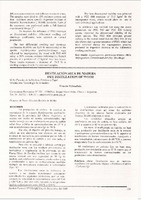Destilación seca de madera
Dry distillation of wood
Abstract
La producción de carbón de residuos de aserraderos de la especie Aspidospernta quebracho-blanco en la provincia del Chaco, Argentina, se realiza por medio de koalas convencionales, tipo media naranja con un rendimiento en peso de carbón sobre base anhidra de aproximadamente un 25 % y con un rendimiento en carbono fijo de 74 %.
Por ello, el objetivo del presente trabajo, es inferir en una alternativa más eficiente del uso de residuos de aserraderos para optimizar por un lado el rendimiento en peso de carbón y por otro lado, el rendimiento en carbono fijo.
Para ello, se procedió a fabricar carbón por destilación seca, con los residuos provenientes de aserraderos y carpinterías de Ia provincia, en una Planta Piloto de Destilación Seca que consta de una retorta vertical con una capacidad de 50 kg de madera, con calefacción indirecta; condensador a aire y condensador a agua en contracorriente; medidor múltiple de temperatura conectado a termocuplas Tipo “K”.
Las destilaciones secas se realizaron de acuerdo a un diseño experimental compuesto controlando los siguientes parámetros, por un !ado, variando la velocidad de calentamiento entre 60 °C/h y 120 °C/h y, por otro lado, variando In temperature final de carbonización entre 450 °C y 550 °C.
Los residuos utilizados para la realización de las destilaciones secas así como los carbones obtenidos de las mismas fueron analizados por Normas IRAM referentes al tetra.
Los resultados obtenidos arrojan un rendimiento en peso de carbón, en base anhidra, del 48 % y superior al 82 % en carbono fijo.
En suma, el rendimiento de carbón, en base seca, producto por destilación seca de la especie Aspidosperma quebracho-blanco es 48 % superior al rendimiento de hornos convencionales, trabajando a una velocidad de calentamiento de 60 °C/h y con una temperatura final de carbonización de 450 °C.
El rendimiento en carbono fijo en base seca, producido por destilación seca es 13 % mayor que el rendimiento de hornos convencionales en los parámetros antes mencionados. The charcoal that is produced in the Province of Chaco, Argentina comes mainly from rubbish from sawmills and carpenter's shops.
The species Aspidosperma quebracho-blanco is the most abundant in the region of Parque Chaqueno and the charcoal, which comes from it, is the best paid in the market. The production of charcoal from this species is made in conventional furnaces, like the ones used in the building industry, with a charcoal yield of an approximately 25 670 and a fixed carbon content of 74 %, both percentages upon a dry basis.
Because of the above mentioned, the reason for this investigation is to infer a more efficient alternative in the use of sawmill rubbish, from the destructive distillation, to improve on one hand the yield of the charcoal, and on the other hand, its contents of fixed carbon.
To do so, charcoal was produced from Aspidosperma quebracho-blanco through destructive distillation. This ramaterial, which came from the rubbish from sawmills of the whole province, was processed in a Destructive Distillation Pilot Plant which has a vertical retort, with enough room for 50 kg of wood, with indirect heating; an air condenser and a cross-current water one, a multiple temperature meter connected to a thermocouple type "K".
The destructive distillations were made according to a Central Composites Design controlling the following parameters: on one hand, changing the heating rate between 60 °C/h and 120 °C/h, and on the other hand, changing the final temperature of carbonisation between 450°C and 550 °C.
The rubbish used for the destructive distillation and the charcoal obtained from it were analysed under specific Argentine Institute of Material Rationalisation Standards (IRAM).
The results obtained show a yield of approximately a 48 % of charcoal and a fixed carbon yield greater than 82 %, both of them on a dry basis. To sum up, the charcoal yield, on a dry basis, produced by rubbish destructive distillation of the species Aspidosperma quebracho-blanco is enlarged in a 49 % as regards the conventional furnaces, working at a heating rate of 60 °C/h and with a final temperature of carbonisation of 450 °C.
The fixed carbon yield, on a dry basis, obtained by rubbish destructive distillation, is about a 13 % greater than the average in relation to the conventional.
Collections
- Revista Yvyraretá [360]
The following license files are associated with this item:




